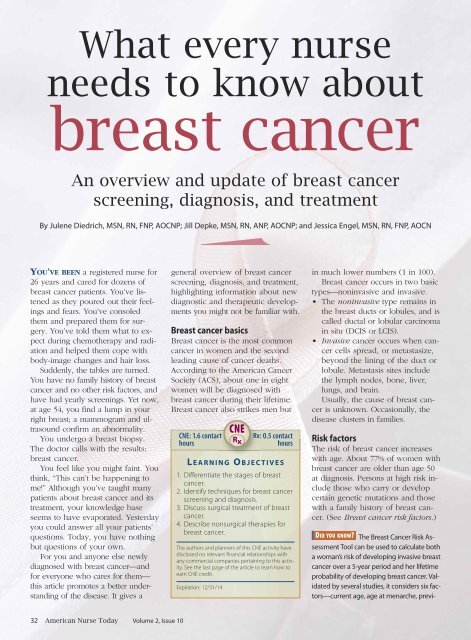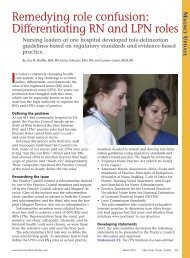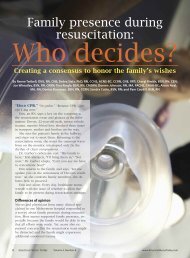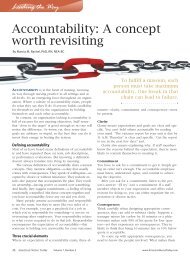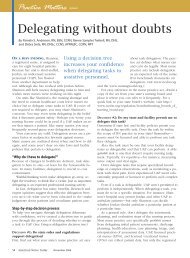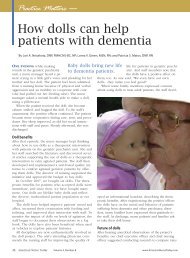Breast cancer risk factors - American Nurse Today
Breast cancer risk factors - American Nurse Today
Breast cancer risk factors - American Nurse Today
Create successful ePaper yourself
Turn your PDF publications into a flip-book with our unique Google optimized e-Paper software.
What every nurse<br />
needs to know about<br />
breast <strong>cancer</strong><br />
An overview and update of breast <strong>cancer</strong><br />
screening, diagnosis, and treatment<br />
<br />
By Julene Diedrich, MSN, RN, FNP, AOCNP; Jill Depke, MSN, RN, ANP, AOCNP; and Jessica Engel, MSN, RN, FNP, AOCN<br />
YOU’VE BEEN a registered nurse for<br />
26 years and cared for dozens of<br />
breast <strong>cancer</strong> patients. You’ve listened<br />
as they poured out their feelings<br />
and fears. You’ve consoled<br />
them and prepared them for surgery.<br />
You’ve told them what to expect<br />
during chemotherapy and radiation<br />
and helped them cope with<br />
body-image changes and hair loss.<br />
Suddenly, the tables are turned.<br />
You have no family history of breast<br />
<strong>cancer</strong> and no other <strong>risk</strong> <strong>factors</strong>, and<br />
have had yearly screenings. Yet now,<br />
at age 54, you find a lump in your<br />
right breast; a mammogram and ultrasound<br />
confirm an abnormality.<br />
You undergo a breast biopsy.<br />
The doctor calls with the results:<br />
breast <strong>cancer</strong>.<br />
You feel like you might faint. You<br />
think, “This can’t be happening to<br />
me!” Although you’ve taught many<br />
patients about breast <strong>cancer</strong> and its<br />
treatment, your knowledge base<br />
seems to have evaporated. Yesterday<br />
you could answer all your patients’<br />
questions. <strong>Today</strong>, you have nothing<br />
but questions of your own.<br />
For you and anyone else newly<br />
diagnosed with breast <strong>cancer</strong>—and<br />
for everyone who cares for them—<br />
this article promotes a better understanding<br />
of the disease. It gives a<br />
general overview of breast <strong>cancer</strong><br />
screening, diagnosis, and treatment,<br />
highlighting information about new<br />
diagnostic and therapeutic developments<br />
you might not be familiar with.<br />
<strong>Breast</strong> <strong>cancer</strong> basics<br />
<strong>Breast</strong> <strong>cancer</strong> is the most common<br />
<strong>cancer</strong> in women and the second<br />
leading cause of <strong>cancer</strong> deaths.<br />
According to the <strong>American</strong> Cancer<br />
Society (ACS), about one in eight<br />
women will be diagnosed with<br />
breast <strong>cancer</strong> during their lifetime.<br />
<strong>Breast</strong> <strong>cancer</strong> also strikes men but<br />
CNE: 1.6 contact<br />
hours<br />
L E A R N I N G O B J E C T I V E S<br />
1. Differentiate the stages of breast<br />
<strong>cancer</strong>.<br />
2. Identify techniques for breast <strong>cancer</strong><br />
screening and diagnosis.<br />
3. Discuss surgical treatment of breast<br />
<strong>cancer</strong>.<br />
4. Describe nonsurgical therapies for<br />
breast <strong>cancer</strong>.<br />
The authors and planners of this CNE activity have<br />
disclosed no relevant financial relationships with<br />
any commercial companies pertaining to this activity.<br />
See the last page of the article to learn how to<br />
earn CNE credit.<br />
Expiration: 12/31/14<br />
CNE<br />
Rx<br />
Rx: 0.5 contact<br />
hours<br />
in much lower numbers (1 in 100).<br />
<strong>Breast</strong> <strong>cancer</strong> occurs in two basic<br />
types—noninvasive and invasive.<br />
• The noninvasive type remains in<br />
the breast ducts or lobules, and is<br />
called ductal or lobular carcinoma<br />
in situ (DCIS or LCIS).<br />
• Invasive <strong>cancer</strong> occurs when <strong>cancer</strong><br />
cells spread, or metastasize,<br />
beyond the lining of the duct or<br />
lobule. Metastasis sites include<br />
the lymph nodes, bone, liver,<br />
lungs, and brain.<br />
Usually, the cause of breast <strong>cancer</strong><br />
is unknown. Occasionally, the<br />
disease clusters in families.<br />
Risk <strong>factors</strong><br />
The <strong>risk</strong> of breast <strong>cancer</strong> increases<br />
with age. About 77% of women with<br />
breast <strong>cancer</strong> are older than age 50<br />
at diagnosis. Persons at high <strong>risk</strong> include<br />
those who carry or develop<br />
certain genetic mutations and those<br />
with a family history of breast <strong>cancer</strong>.<br />
(See <strong>Breast</strong> <strong>cancer</strong> <strong>risk</strong> <strong>factors</strong>.)<br />
DID YOU KNOW The <strong>Breast</strong> Cancer Risk Assessment<br />
Tool can be used to calculate both<br />
a woman’s <strong>risk</strong> of developing invasive breast<br />
<strong>cancer</strong> over a 5-year period and her lifetime<br />
probability of developing breast <strong>cancer</strong>. Validated<br />
by several studies, it considers six <strong>factors</strong>—current<br />
age, age at menarche, previ-<br />
32 <strong>American</strong> <strong>Nurse</strong> <strong>Today</strong> Volume 2, Issue 10
ous breast biopsies, age at first live birth,<br />
history of breast <strong>cancer</strong> in first-degree relatives,<br />
and race or ethnicity. The tool is available<br />
at www.<strong>cancer</strong>.gov/bc<strong>risk</strong>tool.<br />
Genetic <strong>risk</strong> <strong>factors</strong><br />
<strong>Breast</strong> <strong>cancer</strong> has a genetic basis in<br />
about 5% to 10% of cases, with multiple<br />
genetic defects implicated.<br />
Genes associated with an increased<br />
<strong>risk</strong> of breast <strong>cancer</strong> include:<br />
• breast <strong>cancer</strong> 1, early onset<br />
(BRCA1)<br />
• breast <strong>cancer</strong> 2, early onset<br />
(BRCA2)<br />
• CHK2 checkpoint homolog<br />
(CHEK2)<br />
• tumor protein p53 (TP53).<br />
DID YOU KNOW BRCA1 and BRCA2 are major<br />
genes whose mutations are linked to<br />
breast <strong>cancer</strong>. Normally, these genes function<br />
as tumor suppressor genes; if they<br />
mutate and allow unregulated cell growth,<br />
breast <strong>cancer</strong> may occur. About 36% to<br />
85% of women with an altered BRCA1 or<br />
BRCA2 gene develop breast <strong>cancer</strong>. Blood<br />
testing can reveal BRCA1 and BRCA2 mutations<br />
and is commonly done in conjunction<br />
with genetic counseling.<br />
The most common genetic mutation<br />
in <strong>cancer</strong> cells involves the TP53<br />
gene. Normally, the p53 gene product<br />
recognizes damaged DNA and<br />
directs the cell to perform apoptosis<br />
(suicide). A p53 mutation leads to<br />
uncontrolled cell growth and subsequent<br />
<strong>cancer</strong>. More research is needed<br />
to find out if p53 testing should<br />
be recommended to help determine<br />
prognosis in breast <strong>cancer</strong> patients.<br />
The <strong>risk</strong> of genetically based<br />
breast <strong>cancer</strong> is greatest in persons<br />
of Eastern-European Jewish background<br />
and in families where:<br />
• multiple breast <strong>cancer</strong> cases have<br />
occurred<br />
• members have been diagnosed<br />
with both breast and ovarian<br />
<strong>cancer</strong><br />
• members have been diagnosed<br />
with breast <strong>cancer</strong> at an early age<br />
• one or more members have had<br />
two primary breast <strong>cancer</strong>s<br />
<strong>Breast</strong> <strong>cancer</strong><br />
<strong>risk</strong> <strong>factors</strong><br />
Risk <strong>factors</strong> for breast <strong>cancer</strong> fall into<br />
three broad categories based on the<br />
degree to which they increase the<br />
patient’s <strong>risk</strong>.<br />
The following <strong>factors</strong> increase the<br />
breast <strong>cancer</strong> <strong>risk</strong> slightly:<br />
• consuming two to five alcoholic<br />
drinks daily<br />
• breast biopsy showing hyperplasia<br />
without atypia<br />
• increased breast density on mammogram<br />
• obesity or weight gain after<br />
menopause<br />
• postmenopausal hormone replacement<br />
therapy (estrogen plus<br />
progestin).<br />
Factors that increase the <strong>risk</strong> moderately<br />
include:<br />
• age older than 30 at birth of first<br />
child<br />
• age younger than 12 at the time<br />
of first menstrual period<br />
• hyperplasia with atypia on breast<br />
biopsy<br />
• a mother or sister with breast or<br />
ovarian <strong>cancer</strong><br />
• older age at menopause.<br />
Factors that may strongly increase<br />
the <strong>risk</strong> of breast <strong>cancer</strong> are:<br />
• older age<br />
• inherited abnormalities in the<br />
BRCA1 or BRCA2 genes<br />
• chest radiation at a young age<br />
• personal history of breast <strong>cancer</strong>.<br />
• males have had breast <strong>cancer</strong>.<br />
Reducing breast <strong>cancer</strong> <strong>risk</strong><br />
Strategies to help detect and prevent<br />
breast <strong>cancer</strong> include regular screening<br />
for all women, lifestyle changes<br />
(such as weight control and exercise),<br />
preventive surgery (such as prophylactic<br />
mastectomy or oophorectomy),<br />
and chemoprevention with tamoxifen<br />
or raloxifene for certain women.<br />
DID YOU KNOW The STAR (Study of Tamoxifen<br />
and Raloxifene) trial, a breast <strong>cancer</strong><br />
prevention trial, found that raloxifene (currently<br />
used to prevent and treat osteoporosis<br />
in postmenopausal women) works<br />
as well as tamoxifen in reducing breast<br />
<strong>cancer</strong> <strong>risk</strong> in high-<strong>risk</strong> postmenopausal<br />
women. Both drugs reduced invasive<br />
breast <strong>cancer</strong> <strong>risk</strong> by about 50%, but<br />
women receiving raloxifene had 36% fewer<br />
uterine <strong>cancer</strong>s and 29% fewer blood<br />
clots than those receiving tamoxifen.<br />
Raloxifene is under review by the Food<br />
and Drug Administration (FDA) for approval<br />
as breast <strong>cancer</strong> chemoprevention.<br />
<strong>Breast</strong> <strong>cancer</strong> screening<br />
The ACS recommends the following<br />
screening guidelines for breast <strong>cancer</strong>:<br />
• yearly mammograms starting at<br />
age 40<br />
• clinical breast exams every 3<br />
years for women in their 20s and<br />
30s, and yearly for women ages<br />
40 and older<br />
• magnetic resonance imaging<br />
(MRI) scanning and mammography<br />
every year for women at<br />
higher <strong>risk</strong> (greater than 20% lifetime<br />
<strong>risk</strong>), starting at age 30.<br />
Women at moderately increased<br />
<strong>risk</strong> should talk with their primary<br />
care providers about the benefits<br />
and limitations of adding MRI<br />
screening to their yearly mammogram.<br />
(Yearly MRI screening isn’t<br />
recommended for women with a<br />
low lifetime breast <strong>cancer</strong> <strong>risk</strong>.)<br />
DID YOU KNOW In studies, MRI found breast<br />
<strong>cancer</strong> in women at an earlier stage (stage<br />
0 to I) than in women who didn’t undergo<br />
MRIs (stage I to II). Overall MRI sensitivity<br />
in high-<strong>risk</strong> patients ranges from 71% to<br />
100%, compared to 16% to 40% for mammography<br />
sensitivity. However, MRI isn’t<br />
recommended for general screening because<br />
of high false-positive rates.<br />
Starting in their 20s, breast selfexam<br />
is an option for women. The<br />
ACS advises women to become<br />
familiar with how their breasts feel<br />
normally and report any change<br />
promptly to their healthcare<br />
providers.<br />
Assessment and diagnosis<br />
<strong>Breast</strong> <strong>cancer</strong> may present as a<br />
October 2007 <strong>American</strong> <strong>Nurse</strong> <strong>Today</strong> 33
<strong>Breast</strong> <strong>cancer</strong> stage grouping<br />
palpable breast mass, breast pain,<br />
lymph node swelling, or skin<br />
changes, such as dimpling or redness.<br />
Evaluation of a breast abnormality<br />
usually starts with a clinical<br />
breast examination and mammography<br />
or ultrasonography, with MRI<br />
considered for some patients.<br />
The next step is a needle biopsy<br />
or surgical excisional biopsy. To determine<br />
if the <strong>cancer</strong> has spread, the<br />
patient may undergo additional tests,<br />
such as X-ray, computed tomography<br />
(CT), a bone scan, and fluorodeoxyglucose<br />
(FDG) positron emission<br />
tomography (PET) integrated<br />
with CT (FDG-PET/CT).<br />
Cancer staging<br />
Cancer staging helps to determine<br />
appropriate treatment and estimate<br />
prognosis. Like other <strong>cancer</strong>s, breast<br />
<strong>cancer</strong> is staged using the TNM system—tumor<br />
size (T), nodal involvement<br />
(N), and metastasis (M).<br />
Once the TNM categories have<br />
been assigned, the clinician assigns<br />
an overall stage of 0, I, II, III, or IV.<br />
These stages identify tumor types<br />
that have a similar outlook and thus<br />
are treated in a similar way. For descriptions<br />
of breast <strong>cancer</strong> stages<br />
and treatments based on guidelines<br />
from the National Comprehensive<br />
Cancer Network (NCCN), see <strong>Breast</strong><br />
<strong>cancer</strong> stage grouping.<br />
Histopathologic type and grade<br />
Other <strong>factors</strong> used to guide treatment<br />
and determine prognosis include the<br />
tumor’s histopathologic type and<br />
grade. Histopathologic breast <strong>cancer</strong><br />
types include in situ, ductal, invasive,<br />
inflammatory, medullary, mucinous,<br />
papillary, lobular, and tubular.<br />
Tumor grade refers to the extent<br />
to which the <strong>cancer</strong> cell resembles<br />
a normal cell. <strong>Breast</strong> <strong>cancer</strong> cells<br />
have three grades—low, intermediate,<br />
and high. In low-grade <strong>cancer</strong>,<br />
cells most resemble a normal cell<br />
and prognosis is more favorable. In<br />
high-grade <strong>cancer</strong>, cells look least<br />
like a normal cell and the prognosis<br />
is less favorable.<br />
Stage groupings identify tumor types that have a similar outlook and thus warrant<br />
similar treatment. (For more information on staging, visit the National Comprehensive<br />
Cancer Network website at www.nccn.org.)<br />
Stage Description Treatment<br />
0 Noninvasive <strong>cancer</strong> (ductal For DCIS:<br />
carcinoma in situ [DCIS] or • Lumpectomy plus whole-breast<br />
lobular carcinoma in situ irradiation or mastectomy<br />
[LCIS]) • Lymph-node sampling not indicated<br />
• Consideration of tamoxifen as prevention<br />
For LCIS:<br />
• Observation and/or <strong>risk</strong>-reduction<br />
interventions, such as tamoxifen for<br />
premenopausal women or tamoxifen or<br />
raloxifene for postmenopausal women<br />
• In special circumstances, bilateral<br />
mastectomy (with or without<br />
reconstruction) for <strong>risk</strong> reduction<br />
I Cancer confined to a single • Lumpectomy plus whole-breast radiation,<br />
breast site and measuring or mastectomy and possible radiation<br />
less than 2 cm • Possible chemotherapy, antiestrogen<br />
therapy, or targeted therapy<br />
II Tumor larger than 2 cm, or • Lumpectomy plus radiation therapy,<br />
tumor that has spread to or mastectomy and possible radiation<br />
involve several lymph nodes (depending on number of lymph<br />
(one to three axillary nodes or nodes involved)<br />
the internal mammary node) • Possible chemotherapy, antiestrogen<br />
therapy, or targeted therapy<br />
III Tumor larger than 2 cm with • Preoperative (neoadjuvant) chemotherapy,<br />
more extensive nodal<br />
followed by lumpectomy plus radiation;<br />
involvement, or tumor that or mastectomy plus possible radiation<br />
directly involves the chest (depending on number of lymph nodes<br />
wall or skin<br />
involved)<br />
• Possible postoperative chemotherapy,<br />
antiestrogen therapy, or targeted therapy<br />
Inflam- Less common breast <strong>cancer</strong> • Usually starts with chemotherapy, which<br />
matory type; skin is inflamed, red, generally is followed by surgery,<br />
(stage and warm and may show radiation, targeted therapy, and/or<br />
IIIB) ridges, wheals, or pitting. antiestrogen therapy<br />
IV Cancer that has spread to • Chemotherapy, targeted therapy, or<br />
distant sites, such as liver, antiestrogen therapy<br />
lung, or bone • Surgery for symptom palliation<br />
Hormone-receptor status<br />
The tumor’s hormone-receptor status<br />
also influences prognosis and guides<br />
treatment. Testing can measure the<br />
number of estrogen and progesterone<br />
receptors in the tumor, which<br />
is reported as 0, 1+, 2+, or 3+. A value<br />
of 3+ is considered highly hormone-receptor<br />
positive and suggests<br />
the patient is more likely to respond<br />
well to antiestrogen therapy, such as<br />
tamoxifen or an aromatase inhibitor<br />
(AI). A value of 1+ means the tumor<br />
is borderline estrogen sensitive. A<br />
value of 0 predicts a poor response<br />
to antiestrogen therapy.<br />
HER2 overexpression<br />
A protein on the surface of all<br />
normal cells, human epidermal<br />
growth factor receptor-2 (HER2)<br />
helps regulate cell growth. About<br />
20% of breast <strong>cancer</strong>s overexpress<br />
HER2, making them more inva-<br />
34 <strong>American</strong> <strong>Nurse</strong> <strong>Today</strong> Volume 2, Issue 10
sive, more resistant to chemotherapy,<br />
and more likely to recur.<br />
Over the past few years, determining<br />
the patient’s HER2 status<br />
has become important in managing<br />
breast <strong>cancer</strong> and guiding<br />
treatment.<br />
DID YOU KNOW One test to determine<br />
HER2 status measures HER2 using immunohistochemistry;<br />
the other test counts<br />
HER2 gene copies using a method called<br />
fluorescence in-situ hybridization. Such<br />
tests help predict if the patient would benefit<br />
from trastuzumab (Herceptin), lapatinib<br />
(Tykerb), or pertuzumab (Perjeta)<br />
therapy.<br />
Tumor markers<br />
To help assess breast <strong>cancer</strong>, the patient<br />
may undergo testing for tumor<br />
markers, such as BCA (CA15-3),<br />
CA27.29, and CEA. Measuring these<br />
markers may aid diagnosis, help predict<br />
therapeutic efficacy, and detect<br />
<strong>cancer</strong> recurrence. High levels may indicate<br />
advanced or metastatic <strong>cancer</strong>.<br />
Treatment<br />
<strong>Breast</strong> <strong>cancer</strong> treatment options are<br />
constantly evolving. Treatment decisions<br />
may hinge on many <strong>factors</strong>, including<br />
the patient’s tolerance for the<br />
proposed therapy, patient preference,<br />
and comorbidities. To guide<br />
treatment and manage adverse effects,<br />
clinicians may use guidelines<br />
from the NCCN, <strong>American</strong> Society of<br />
Clinical Oncology, and Oncology<br />
Nursing Society. Clinical trials (listed<br />
at www.<strong>cancer</strong>.gov/clinicaltrials) may<br />
offer additional treatment opportunities.<br />
Recently, treatment has become<br />
more individualized, based on specific<br />
features of the patient’s tumor.<br />
For instance, statistics show that as<br />
a group, patients with early-stage<br />
breast <strong>cancer</strong> don’t benefit from<br />
chemotherapy. Yet some of these<br />
patients have tumor characteristics<br />
that suggest chemotherapy would<br />
be helpful.<br />
DID YOU KNOW Multigene assays can help<br />
determine if breast <strong>cancer</strong> will respond to<br />
treatment. The MammoPrint test is used in<br />
patients younger than age 55 with stage I<br />
invasive <strong>cancer</strong> or stage II node-negative<br />
invasive <strong>cancer</strong>. Another assay, Oncotype-<br />
DX, identifies a 21-gene cohort and is used<br />
for newly diagnosed stage I or II nodenegative,<br />
estrogen-receptor-positive <strong>cancer</strong>.<br />
A low score means the patient may not benefit<br />
from chemotherapy; a high score suggests<br />
chemotherapy might be worthwhile.<br />
Surgery and adjuvant therapy<br />
Surgery is the definitive treatment for<br />
breast <strong>cancer</strong>. Usually, the patient receives<br />
adjuvant therapy in addition<br />
to the first therapeutic modality she<br />
undergoes. When surgery is the primary<br />
treatment, adjuvant therapy<br />
may consist of chemotherapy, radiation<br />
therapy, or antiestrogen therapy<br />
given afterward.<br />
In neoadjuvant treatment, chemotherapy<br />
is given first to shrink a<br />
large tumor before surgery and thus<br />
allow a breast conservation technique<br />
(such as lumpectomy). It also<br />
may be used if surgery isn’t feasible<br />
at the time of diagnosis.<br />
<strong>Breast</strong> reconstruction is an option<br />
for some women who’ve had mastectomies.<br />
Reconstruction may involve<br />
breast expanders, implants,<br />
autologous tissue reconstruction, or<br />
a combination.<br />
Lymph node biopsy<br />
Traditionally, patients with invasive<br />
breast <strong>cancer</strong> have undergone axillary<br />
lymph-node dissection to find<br />
out if <strong>cancer</strong> cells have spread to<br />
the axillary nodes. During this procedure,<br />
the surgeon removes the<br />
lymph node tissue that drains from<br />
the breast, and a pathologist determines<br />
if any of the nodes contains<br />
<strong>cancer</strong>. Full axillary node dissection<br />
can lead to such complications as<br />
lymphedema, neuropathy, and increased<br />
discomfort.<br />
DID YOU KNOW Sentinel lymph-node mapping<br />
offers an alternative to traditional axillary<br />
lymph-node dissection in patients<br />
with presumed early-stage disease, and<br />
can eliminate the need for full node dissection.<br />
This mapping technique identifies<br />
the sentinel (first) axillary lymph nodes (the<br />
ones most likely to be <strong>cancer</strong>ous) based<br />
on the breast’s primary lymphatic drainage<br />
pattern. To map the sentinel nodes, a radioactive<br />
tracer and blue dye are injected in<br />
the breast tissue and carried by lymph<br />
fluid as it drains to the nodes. The nodes<br />
that take up the tracer and dye are identified<br />
and removed. A positive sentinel<br />
node indicates the need for a full axillary<br />
lymph-node dissection; negative sentinel<br />
nodes suggest other axillary nodes are<br />
<strong>cancer</strong> free.<br />
Radiation therapy<br />
Partial-breast radiation may involve<br />
internal, intraoperative, or external<br />
beam radiation.<br />
• In internal partial-breast radiation<br />
(also called brachytherapy), radioactive<br />
seeds are inserted into<br />
the tumor bed.<br />
• Intraoperative partial-breast radiation<br />
uses a linear accelerator to<br />
administer radiation to the tumor<br />
bed and surrounding area during<br />
surgery, after tumor removal.<br />
• External beam partial-breast radiation<br />
begins with careful selection<br />
of the treatment field, followed by<br />
radiation delivered to the marked<br />
area with a linear accelerator.<br />
Adverse effects of radiation therapy<br />
include fatigue and local skin<br />
reactions, such as discoloration,<br />
itching, soreness, and peeling. Late<br />
and long-term adverse effects also<br />
may occur. (See Late and long-term<br />
adverse effects of breast <strong>cancer</strong><br />
treatments.)<br />
DID YOU KNOW Clinical trials are underway<br />
to compare partial-breast radiation<br />
to whole-breast radiation (the current<br />
standard). The latter is given by external<br />
beam to the entire breast and chest wall<br />
for 5 days weekly for up to 7 weeks. Partial-breast<br />
radiation is given in higher daily<br />
doses to the surgical cavity and margin<br />
over a shorter period. The trials may determine<br />
if the partial-breast technique is<br />
as effective as whole-breast radiation<br />
while speeding treatment time and causing<br />
fewer adverse effects.<br />
October 2007 <strong>American</strong> <strong>Nurse</strong> <strong>Today</strong> 35
Late and long-term adverse effects of breast <strong>cancer</strong> treatments<br />
Besides immediate adverse effects, breast <strong>cancer</strong> treatments can cause problems<br />
that arise later or last for a long time, including:<br />
• late adverse effects—those occurring months or longer after treatment ends<br />
• long-term adverse effects—those starting before and ending after treatment ends.<br />
This chart lists some potential effects of the main types of <strong>cancer</strong> treatments.<br />
Treatment Long-term effects Late effects<br />
Chemotherapy • Decreased libido • Cataracts<br />
• Fatigue<br />
• Hepatic problems<br />
• Heart failure<br />
• Infertility<br />
• Hepatic problems • Lung disease<br />
• Infertility<br />
• Reduced lung capacity<br />
• Memory problems • Secondary <strong>cancer</strong>s<br />
• Menopausal symptoms<br />
• Neuropathy<br />
• Premature menopause<br />
• Renal failure<br />
• Vaginal dryness<br />
Antiestrogen therapy • Osteoporosis • Endometrial <strong>cancer</strong><br />
Radiation therapy • Fatigue • Brachial plexopathy<br />
• Skin sensitivity<br />
• Heart problems<br />
• Hypothyroidism<br />
• Lung disease<br />
• Lymphedema<br />
• Pneumonitis<br />
• Secondary <strong>cancer</strong>s<br />
Surgery • Altered body image • Brachial plexopathy<br />
• Chronic pain<br />
• Lymphedema<br />
• Decreased range of motion<br />
(arm and shoulder)<br />
• Numbness<br />
• Scars<br />
Targeted therapy • Heart failure Not yet known<br />
Chemotherapy<br />
Chemotherapy may involve a single<br />
antineoplastic drug or a combination<br />
of agents. Most patients with breast<br />
<strong>cancer</strong> receive chemotherapy in 2-<br />
to 3-week cycles, depending on the<br />
regimen. Concomitant administration<br />
of red and white blood cell growth<br />
<strong>factors</strong> may allow dose-dense chemotherapy,<br />
in which cycles are given<br />
closer together (such as every 2<br />
weeks). Typically, breast <strong>cancer</strong><br />
chemotherapy is given I.V., but<br />
some newer drugs used to treat<br />
metastatic disease are given orally.<br />
Although chemotherapy targets<br />
<strong>cancer</strong> cells, it can also damage<br />
normal cells—especially the rapidly<br />
dividing cells of the GI tract, skin,<br />
hair, and bone marrow. Damage to<br />
normal cells can cause nausea,<br />
vomiting, diarrhea, hair loss, decreased<br />
blood counts, fatigue, and<br />
neuropathy.<br />
The newest chemotherapy agents<br />
currently used in metastatic breast<br />
<strong>cancer</strong> are eribulin (given alone) and<br />
ixabepilone (given with capecitabine).<br />
They both are microtubule<br />
inhibitors<br />
DID YOU KNOW Techniques have been developed<br />
to administer chemotherapy. For<br />
instance, using nanotechnology, one drug<br />
maker manufactures paclitaxel in an albumin-bound<br />
form. The FDA has approved<br />
this drug form for metastatic breast <strong>cancer</strong><br />
treatment. Called paclitaxel proteinbound<br />
(Abraxane), it falls under the category<br />
of protein-bound particle drugs.<br />
Antiestrogen therapy<br />
Patients with estrogen- or progesteronepositive<br />
breast <strong>cancer</strong> may be candidates<br />
for antiestrogen therapy,<br />
which reduces the amount of estrogen<br />
available to <strong>cancer</strong> cells. One<br />
type of antiestrogen therapy uses<br />
selective estrogen-receptor modulators,<br />
such as tamoxifen. By blocking<br />
estrogen receptors in breast<br />
<strong>cancer</strong> cells, tamoxifen stops estrogen<br />
from binding to these receptors<br />
and stimulating <strong>cancer</strong> cell growth.<br />
Tamoxifen can be given to premenopausal<br />
or postmenopausal<br />
women. Adverse effects may include<br />
hot flashes, coagulopathies<br />
(such as deep vein thrombosis),<br />
and endometrial <strong>cancer</strong>.<br />
In the late 1990s, antiestrogen<br />
therapy involving AIs became available<br />
for postmenopausal women<br />
with estrogen- or progesteronepositive<br />
breast <strong>cancer</strong>. Before<br />
menopause, the ovaries produce<br />
most of the body’s estrogen; after<br />
menopause, estrogen comes from<br />
androgen’s conversion to estrogen,<br />
with the enzyme aromatase regulating<br />
a step in this process. AIs<br />
(which include anastrozole, letrozole,<br />
and exemestane) block aromatase<br />
function, halting estrogen<br />
production. Adverse effects include<br />
hot flashes, arthralgia, myalgia, and<br />
osteoporosis.<br />
DID YOU KNOW AIs have begun to replace<br />
tamoxifen as standard treatment for estrogen-<br />
or progesterone-positive breast <strong>cancer</strong>.<br />
The ATAC (Arimidex, Tamoxifen, Alone<br />
or in Combination) trial and other large<br />
clinical trials found AIs more effective than<br />
tamoxifen in postmenopausal patients<br />
with estrogen-receptor-positive <strong>cancer</strong>.<br />
Targeted therapies<br />
Targeted therapies use agents that<br />
interfere with specific molecules involved<br />
in carcinogenesis and<br />
tumor growth. By focusing on <strong>cancer</strong>-specific<br />
molecular and cellular<br />
changes, these therapies may be<br />
more effective than current treatments<br />
and may cause less harm to<br />
36 <strong>American</strong> <strong>Nurse</strong> <strong>Today</strong> Volume 2, Issue 10
normal cells. Recent advances in targeted<br />
therapy for breast <strong>cancer</strong> include<br />
the drugs trastuzumab, bevacizumab,<br />
pertuzumab, and lapatinib.<br />
Trastuzumab (Herceptin) targets<br />
HER2-positive <strong>cancer</strong> cells. By<br />
binding to the HER2 receptor on<br />
the cell surface, it may trigger the<br />
body's defense system to destroy<br />
that cell. The drug interrupts the<br />
cell’s growth signal, halting cell<br />
proliferation. Adverse effects include<br />
flulike symptoms, nausea,<br />
and cardiac changes that can lead<br />
to heart failure.<br />
Bevacizumab (Avastin) stops tumor<br />
growth by targeting and inhibiting<br />
the function of vascular endothelial<br />
growth factor, a protein that<br />
promotes angiogenesis. In combination<br />
with paclitaxel, bevacizumab<br />
is used for metastatic breast <strong>cancer</strong>.<br />
Studies show the combination improves<br />
progression-free survival.<br />
Possible adverse effects of bevacizumab<br />
include bleeding, hypertension,<br />
proteinuria, weakness, pain,<br />
and fatigue.<br />
Lapatinib (Tykerb) is approved<br />
in combination with capecitabine<br />
(Xeloda) to treat HER2-positive<br />
metastatic breast <strong>cancer</strong>s that don’t<br />
respond to chemotherapy or<br />
trastuzumab. Lapatinib binds to<br />
epidermal growth factor receptor-1<br />
and HER2 receptors, stopping the<br />
cell from growing. The combination<br />
of lapatinib and capecitabine<br />
delayed breast <strong>cancer</strong> progression<br />
for nearly twice as long as capecitabine<br />
alone (4.4 months vs. 8.4<br />
months). Possible adverse effects<br />
of the drug combination include<br />
diarrhea, nausea, vomiting, rash,<br />
and hand-foot syndrome.<br />
Surviving breast <strong>cancer</strong><br />
Hearing that you or a loved one<br />
has breast <strong>cancer</strong> is a shock. But<br />
breast <strong>cancer</strong> usually doesn’t<br />
equate to death. Earlier detection<br />
through screening, increased<br />
awareness, and improved treatment<br />
have led to a continuing decline<br />
in mortality. According to the<br />
ACS, relative survival rates for<br />
women with breast <strong>cancer</strong> are:<br />
• 89% at 5 years after diagnosis<br />
• 82% after 10 years<br />
• 77% after 15 years.<br />
More than 2 million people in the<br />
United States are breast <strong>cancer</strong> survivors,<br />
and the number continues to<br />
grow. Urge all patients who’ve had<br />
breast <strong>cancer</strong> to get routine followup<br />
care. Such care allows early detection<br />
of a recurrence or a new primary<br />
<strong>cancer</strong> and helps ensure that<br />
the patient is assessed and treated<br />
for late and long-term effects of <strong>cancer</strong><br />
treatment.<br />
Survivors know a diagnosis of<br />
breast <strong>cancer</strong> is a lifelong journey.<br />
Uncertain of the future, most live<br />
with the fear that <strong>cancer</strong> will recur.<br />
As nurses, we have the<br />
chance to support them from the<br />
time of diagnosis through treatment—and<br />
beyond.<br />
✯<br />
Selected references<br />
<strong>American</strong> Cancer Society breast <strong>cancer</strong> facts<br />
& figures, 2011-2012. Available at: http://<br />
www.<strong>cancer</strong>.org/acs/groups/content/@<br />
epidemiologysurveilance/documents/document/<br />
acspc-030975.pdf. Accessed November 9, 2012.<br />
<strong>American</strong> Cancer Society. What are the <strong>risk</strong><br />
<strong>factors</strong> for breast <strong>cancer</strong> Available at:<br />
www.<strong>cancer</strong>.org/docroot/CRI/content/CRI_2_4<br />
_2X_What_are_the_<strong>risk</strong>_<strong>factors</strong>_for_breast_<strong>cancer</strong>_5.aspsitearea=.<br />
Accessed August 22, 2007.<br />
Isaacs MD, Claudine, Fletcher MD, Suzanne<br />
and Peshkin, Beth MD for the Up To Date<br />
site. Available at: http://www.uptodate.com/<br />
contents/genetic-testing-for-hereditary-breastand-ovarian-<strong>cancer</strong>-syndromesource=search<br />
_result&search=breast+<strong>cancer</strong>+genetic+<br />
testing&selectedTitle=1%7E150. Accessed November<br />
9, 2012.<br />
Muss H. Targeted therapy for metastatic breast<br />
<strong>cancer</strong>. N Engl J Med. 2006;355(26):2783-2785.<br />
National Cancer Institute. <strong>Breast</strong> <strong>cancer</strong><br />
(PDQ ® ): treatment. Available at: www.<strong>cancer</strong><br />
.gov/<strong>cancer</strong>topics/pdq/treatment/breast/Healt<br />
hProfessional. Accessed August 22, 2007.<br />
National Cancer Institute. Targeted therapies.<br />
Available at: http://www.<strong>cancer</strong>.gov/<strong>cancer</strong>topics/factsheet/Therapy/targeted.<br />
Accessed<br />
November 9, 2012.<br />
Ravdin P, Cronin K, Howlader N, et al. The<br />
decrease in breast-<strong>cancer</strong> incidence in 2003 in<br />
the United States. N Engl J Med. 2007;356(16):<br />
1670-1674.<br />
Saslow D, Boetes C, Burke W, et al, for the<br />
<strong>American</strong> Cancer Society <strong>Breast</strong> Cancer Advisory<br />
Group. <strong>American</strong> Cancer Society guidelines<br />
for breast screening with MRI as an adjunct<br />
to mammography. CA Cancer J Clin.<br />
2007;57(2):75-89.<br />
The authors are Oncology <strong>Nurse</strong> Practitioners at the<br />
Marshfield Clinic, which has centers throughout<br />
Wisconsin. Julene Diedrich, MSN, RN, FNP, AOCNP, and<br />
Jessica Engel, MSN, RN, FNP, AOCN, work at the<br />
Marshfield center. Jill Depke, MSN, RN, ANP, AOCNP,<br />
works at the Weston center.<br />
CNE POST-TEST — What every nurse needs to know about breast <strong>cancer</strong><br />
Instructions<br />
To take the post-test for this article and earn contact hour credit, please<br />
go to www.<strong>American</strong><strong>Nurse</strong><strong>Today</strong>.com. Simply use your Visa or Master-<br />
Card to pay the processing fee. (Online: ANA members $15; nonmembers<br />
$20.) Once you’ve successfully passed the post-test and completed the<br />
evaluation form, you’ll be able to print out your certificate immediately.<br />
If you are unable to take the post-test online, complete the print form<br />
and mail it to the address at the bottom of the next page. (Mail-in test<br />
fee: ANA members $20; nonmembers $25.)<br />
Provider accreditation<br />
The <strong>American</strong> <strong>Nurse</strong>s Association Center for Continuing Education and Professional<br />
Development is accredited as a provider of continuing nursing education by<br />
the <strong>American</strong> <strong>Nurse</strong>s Credentialing Center’s Commission on Accreditation.<br />
ANA is approved by the California Board of Registered Nursing, Provider<br />
Number 6178.<br />
Contact hours: 1.6 Rx contact hours: 0.5<br />
Expiration: 12/31/14 Post-test passing score is 75%.<br />
ANA Center for Continuing Education and Professional Development’s accredited<br />
provider status refers only to CNE activities and does not imply that there is real or<br />
implied endorsement of any product, service, or company referred to in this activity<br />
nor of any company subsidizing costs related to the activity.<br />
Click Here to Register and Take Test at NursingWorld.org:<br />
http://nursingworld.org/ce/journal<br />
October 2007 <strong>American</strong> <strong>Nurse</strong> <strong>Today</strong> 37
POST-TEST • What every nurse needs to know about breast <strong>cancer</strong><br />
Earn contact hour credit online at www.<strong>American</strong><strong>Nurse</strong><strong>Today</strong>.com! (ANT071001updated121101)<br />
CNE: 1.6 contact hours<br />
Rx: 0.5 contact hours<br />
CNE<br />
Rx<br />
1. Which of the following may strongly increase the <strong>risk</strong><br />
of breast <strong>cancer</strong><br />
a. Increased breast density on mammogram<br />
b. Chest radiation at a young age<br />
c. Age younger than 12 at time of first menstrual period<br />
d. Weight gain after menopause<br />
2. The most common genetic mutation in <strong>cancer</strong> cells<br />
involves the:<br />
a. TP53 gene.<br />
b. HER2 gene.<br />
c. CHK2 gene.<br />
d. BRCA2 gene.<br />
3. Your patient has never had a mammogram, and asks<br />
you when she should start getting them. You should tell<br />
her that the <strong>American</strong> Cancer Society (ACS) recommends<br />
annual mammograms starting at what age<br />
a. 30<br />
b. 35<br />
c. 40<br />
d. 45<br />
4. According to the ACS, how often should a patient at<br />
high <strong>risk</strong> for breast <strong>cancer</strong> undergo magnetic resonance<br />
imaging (MRI) scans of the breast<br />
a. Every 6 months starting at age 30<br />
b. Every year starting at age 30<br />
c. Every 6 months starting at age 40<br />
d. Every year starting at age 40<br />
5. Ms. McDonald has a tumor measuring 2.5 cm that<br />
hasn’t spread to the lymph nodes. This indicates she has<br />
which stage of <strong>cancer</strong><br />
a. Stage I<br />
b. Stage II<br />
c. Stage III<br />
d. Stage IV<br />
6. Ms. McDonald’s estrogen- and progesterone-receptor<br />
status is 3+. Which of the following statements about her<br />
tumor is correct<br />
a. The tumor is highly estrogen sensitive and likely to<br />
respond to antiestrogen therapy.<br />
b. The tumor is moderately estrogen sensitive and not<br />
likely to respond to antiestrogen therapy.<br />
c. The tumor is estrogen sensitive and likely to respond<br />
to antiestrogen therapy.<br />
d. The tumor isn’t estrogen sensitive and won’t respond<br />
to antiestrogen therapy.<br />
7. A patient’s breast <strong>cancer</strong> has spread to her liver.<br />
Which stage of <strong>cancer</strong> does she have<br />
a. Stage III<br />
b. Stage IIIB<br />
c. Stage IV<br />
d. Stage V<br />
8. Which of the following is an adverse effect of aromatase<br />
inhibitors<br />
a. Deep vein thrombosis<br />
b. Chills<br />
c. Osteoporosis<br />
d. Endometrial <strong>cancer</strong><br />
9. Which statement about lymph node biopsy in earlystage<br />
<strong>cancer</strong> is accurate<br />
a. The surgeon usually performs a full lymph-node dissection<br />
to determine if the <strong>cancer</strong> has spread.<br />
b. The surgeon identifies the node that’s most likely to<br />
be <strong>cancer</strong>ous and takes a biopsy of that node only.<br />
c. A radioactive tracer and blue dye are used to map the<br />
sentinel lymph nodes.<br />
d. A red dye is injected to identify the sentinel nodes.<br />
10. Which partial-breast radiation therapy uses a linear<br />
accelerator to administer radiation to the tumor bed and<br />
surrounding area during surgery, after tumor removal<br />
a. Intraoperative<br />
b. External beam<br />
c. Internal<br />
d. Postoperative<br />
11. Your patient will receive neoadjuvant treatment. Before<br />
surgery, which of the following is she most likely to<br />
undergo to shrink her tumor and thus allow a breastconservation<br />
technique (such as lumpectomy)<br />
a. MammoPrint test<br />
b. Brachytherapy<br />
c. Tamoxifen therapy<br />
d. Chemotherapy<br />
12. Which of the following chemotherapy drugs involves<br />
nanotechnology<br />
a. Paclitaxel, protein-bound<br />
b. Paclitaxel, carbohydrate-bound<br />
c. Tamoxifen, protein-bound<br />
d. Tamoxifen, carbohydrate-bound<br />
13. Which statement about aromatase inhibitors (AIs) is<br />
true<br />
a. AIs have begun to replace tamoxifen as standard<br />
treatment for estrogen- or progesterone-positive<br />
breast <strong>cancer</strong> in postmenopausal women.<br />
b. AIs can be given only after 2 to 5 years of tamoxifen<br />
therapy.<br />
c. AIs are less effective than tamoxifen in postmenopausal<br />
patients with estrogen-positive <strong>cancer</strong>.<br />
d. AIs stimulate aromatase function, which halts estrogen<br />
production.<br />
14. How does bevacizumab (Avastin) stop tumor growth<br />
a. It prevents new vessel formation by targeting and<br />
binding to endovascular vessel formation factor (EVFF).<br />
b. It prevents new vessel formation by targeting and inhibiting<br />
vascular endothelial growth factor (VEGF).<br />
c. It binds to HER2-positive <strong>cancer</strong> cells, which triggers<br />
the body’s defense system to destroy the cell.<br />
d. It binds to HER2-negative <strong>cancer</strong> cells, which triggers<br />
the body’s defense system to destroy the cell.<br />
15. Ms. Jordan underwent surgery followed by hormonal<br />
therapy to treat breast <strong>cancer</strong>. Six months later, she has<br />
brachial plexopathy. This may be a late adverse effect of:<br />
a. tamoxifen.<br />
b. anastrozole.<br />
c. chemotherapy.<br />
d. breast <strong>cancer</strong> surgery.<br />
38 <strong>American</strong> <strong>Nurse</strong> <strong>Today</strong> Volume 2, Issue 10


